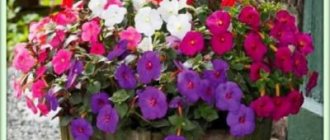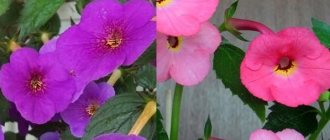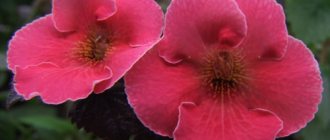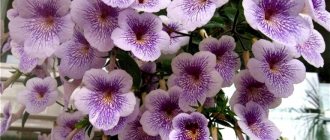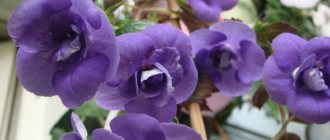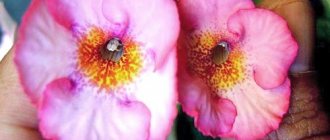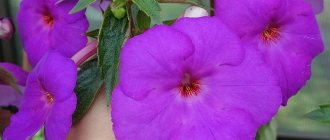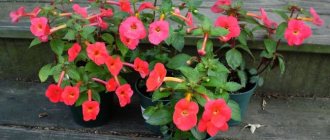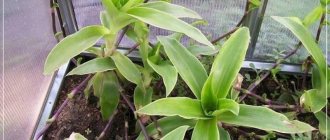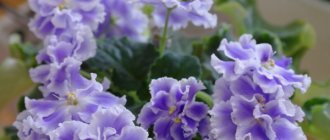It is difficult to imagine that just a couple of decades ago the number of Achimenes varieties available for growing at home was not in the hundreds, as it is today, but in dozens.
Modern lovers of flowering ornamental plants have a unique opportunity to endlessly expand their collections and enjoy new bright and unusual flowers of Achimenes. And yet everyone has their favorites. Photos and descriptions of Achimenes varieties, beloved by flower growers, will become a guide for those who are interested in this plant and want to see bushes covered with flowers on their windowsill.
Achimenes Ambroise Verschaffelt
In 1855, as a result of crossing Achimenes grandiflora var. alba and the cultivar Rinzii, Achimenes Ambroise Verschaffelt was obtained, named after one of Belgium's outstanding gardeners, Ambrose Verschaffelt.
The Achimenes variety that was bred at that time turned out to have a long, happy life. Erect bushes with brownish stems and green foliage are decorated with large flowers. Each corolla bears an openwork network of purple veins, and its center is marked with a bright yellow spot.
Cost of delivery
If you only have Achimenes rhizomes in your order: In Russia: By Russian Post - 280 rubles. (shipping 1st class). To Kazakhstan and Belarus - 400 rubles. Orders from 3000 rub. - free shipping!
Attention, when you add fertilizer to your order, the delivery cost increases (depending on weight). You will see the exact calculation in the cart; if the cost does not suit you, remove fertilizer from the order and the amount will become the minimum standard More about delivery, packaging and shipping temperature conditions
Achimenes Double Picotee Rose
The plant was bred by G.Mossop, is distinguished by its stable flowering and the fact that, according to the description of Achimenes, the medium-sized flowers stably maintain a bizarre shape. The Double Picotee Rose variety is Achimenes, representing a spectacular family of plants with double flowers reminiscent of a rose. The corollas are white, terry, with thin, barely noticeable lilac tones and veins, which become brighter closer to the throat, giving the flower volume and additional attractiveness. The Achimenes bush, as in the photo, is compact, with bright green foliage and pinkish-brown stems. The same shades are present on the back of the leaves.
Varietal diversity
In addition to the natural species of this extraordinary flower, there are also a huge number of varieties bred by breeders. They used wild varieties of Achimenea, and as a result of hybridization, numerous beautiful varieties appeared, distinguished by large inflorescence sizes, unusual appearance, and even colors that are not found in natural growth.
These varieties of Achimenes are considered the most famous and beloved by flower growers.
"Yellow English Rose". A large number of varieties with a flower resembling a rose were created by the famous Romanian breeder Serge Saliba. This variety of Achimenes was first put up for evaluation by flower growers in 2012. It belongs to the type of double Achimenes.
Large (up to 6 cm) lush double flowers have a beautiful clean soft yellow hue and edges with a corrugated and fringed line. To preserve this color of the crop, it is recommended to keep it in places with diffused lighting. When kept in cool conditions, the inflorescence acquires a cream or soft coral hue. During abundant flowering, the bush requires support.
"Double Pink Rose" This variety of Achimenes is characterized by duration, splendor and abundance of flowering. Upright shoots, covered with narrow leaves, branch well and form a dense but neat bush. It blooms with lush double inflorescences of a soft pinkish tone. The flowers are quite large in size.
Achimenes Stan's Delight
Achimenes Stan's Delight bred by G.Mossop can be called one of the oldest terry varieties, since it appeared in 1993 or 1994. Achimenes flowers are distinguished by their densely double shape and carmine or crimson-red coloring of the corollas. At the throat, under the central petals, you can see a yellow spot with dotted burgundy or brownish specks. The edges of the petals are rounded-toothed, which only complements the decorative effect of this Achimenes variety. This plant is characterized by the formation of erect shoots with dark green foliage, on the reverse side having a distinct purple tint.
Peculiarities
Achimenes belongs to the genus of flowering plants from the Gesneriev family. This is a perennial rhizomatous herbaceous plant that blooms in beautiful multi-colored inflorescences. This flower is considered a relative of gloxinia and violet. It is characterized by brightness and abundance of flowering.
The root system is a rhizome in the form of rhizomes, covered with scales and very reminiscent of birch catkins or spruce cones. The flower has weak stems and weakly branching shoots, covered with a dark green shell, sometimes with a reddish tint. Stems can grow vertically or droop and spread.
Achimenes is distinguished by the duration of its flowering - it begins in May and ends only in October. Inflorescences with 5 petals can be single or paired and are characterized by a variety of colors and shades.
The outer surface of the leaves is smooth and shiny, with prominent veins. Their color can be rich green, pinkish and even crimson. The inner side is slightly pubescent. The leaves have an oblong shape, the edges are wavy and finely toothed.
The genus of this flower is distinguished by many species (about 26), varieties and bred hybrids. Achimenes are divided into main types according to the following characteristic features.
- Type of growth of stem and shoots. Achimenes are divided into straight-growing, semi-ampelous and ampelous. In upright-growing achimenes, the stem grows vertically, and the side shoots grow to the sides, forming a bush. Ampelous plant species have a flexible stem that is lowered down and creeping shoots. In semi-ampelous Achimenes, climbing shoots require a direction of growth.
- Plant size. The height of the flower can vary between 25-50 cm.
- Type of inflorescences. Flowers are simple with smooth petals, semi-double or fully double.
- The size of the inflorescences. Achimenes flowers can be small (2.5-3 cm), medium (3-4.5 cm) and large - up to 6 cm in diameter.
- Color color of inflorescences. The color scheme is represented by almost the entire palette of shades: white, various shades of red - from pink to burgundy, purple and blue, yellow and orange. Based on color, two species are particularly distinguished - candida (white) and coccinea (bright red or purplish-red shades).
- Bud shape. They come in round, elongated or bell-shaped shapes.
Achimenes Purple King
The patriarch among popular varieties can be called Achimenes Purple King, bred by Park back in 1936. The plant can also be found under another name. A synonym for this Achimenes variety is the name Royal Purple. This famous variety is characterized by large purplish-violet flowers with fringed petals and a prominent pattern of darker veins.
At the entrance to the pharynx, the corolla has a yellow spot with dark brown speckles. Young shoots are erect, but then, as in the photo of Achimenes, they take on a drooping or semi-ampeloid shape. The leaves of this variety of Achimenes are dark green with a purplish tint at the base and a serrated edge.
'Yellow English Rose'
- Go to page:
'Yellow English Rose'
Post by Izya » June 18, 2013, 00:44
Achimenes 'Yellow English Rose' (S.Saliba 2012)
Another masterpiece. The largest double pure yellow flower that Serge has created so far. Petals with a fringed edge. The flowers look like real English roses. Excellent flowering. A variety for growing in diffused light. Description of Serge.
Rest period
By mid-autumn, Achimenes completely stops blooming, its leaves turn yellow and die . Dried stems should be cut off, and the rhizomes should be left to rest in the same soil or transferred to sand or sawdust.
is recommended to store rhizomes in a dark place at a temperature of 10 - 15 ° C. It is important to ensure that the rhizomes do not dry out by moisturizing them once a month. In the last days of February, the rhizomes of Achimenes are placed on a bright windowsill, gradually increasing watering.
Pests, diseases and ways to combat them
Achimenes are considered resistant to pests and diseases, but errors in agricultural technology can have a bad effect on the condition of the plants. Problems can be eliminated by using appropriate medications and correcting errors in care.
- The buds become brown. This happens if you keep the plant at too high a temperature (from +26 o C and above). Lower the temperature and the problem will go away.
- Brown spots appear on the surface of the leaf. A common cause is watering with cold water. It is better to water the plant with water at room temperature or even lukewarm.
- A gray coating appears on the leaves and buds of Achimenes, they shrink and die. This happens when a flower is damaged by gray rot. This is a fungal disease that develops when water stagnates in a pot. You can avoid it if you water the plant only after the soil has dried. Treatment consists of removing the affected parts of the bush, as well as treating it with a 0.2% solution of Fundazol or another fungicide.
- Ring spot. Occurs if cold water is used for irrigation or the plant is exposed to direct sunlight.
- Yellowing of leaves (except veins). The manifestation of chlorosis, which is the result of watering with hard water or iron deficiency.
- Spider mite. Twice treatment of the plant with acaricides is required. You need to wait a week between treatments. Drugs such as Neoron, Fitoverm, Akarin work well.
- Aphids, mealybugs, whiteflies. Pests are destroyed by watering the flower with Aktara or other insecticides.
A strong plant is less susceptible to pests and diseases, so it is important to fertilize and water in a timely manner, and protect the flower from cold drafts and direct sunlight. Then the achimenes will bloom all summer, delighting you with their beauty.
Reproduction
Achimenes is propagated by dividing rhizomes, using green cuttings and seeds.
Reproduction by rhizomes
The first method is the simplest, since the rhizomes take root very quickly. We carry out propagation during plant transplantation.
We select healthy, dense roots, divide them into two or three parts, sprinkle the sections with ground cinnamon and place several in a pot in a substrate moistened with warm water.
Then we cover it with a layer of soil and cover it with film to create greenhouse conditions.
We place the pot in partial shade. We moisten the earth periodically.
After 2-3 weeks you can see the first shoots. We remove the cover and place the pot with young plants in a well-lit place.
In some hanging varieties, aerial roots-rhizomes are formed on the shoots. They can be separated with part of the stem and placed in the ground for rooting.
Propagation by green cuttings
Propagation by green cuttings is used less frequently. It is carried out at the beginning of summer, using the middle or lower parts of the stems. There should be at least two internodes on them, in this case the bushes will be lush and flowering abundantly. Before planting, the cuttings are treated with a growth stimulator.
Rooting is carried out in a substrate that includes leaf soil and sand in equal quantities. After this, the planting material is slightly moistened, covered with glass jars or polyethylene film and placed in a room with an air temperature of about twenty-two degrees. They need to be removed daily to ventilate the plantings, since when large condensation forms, the cuttings quickly rot.
Top dressing
Achimenes should be fed with fertilizers for flowering plants. But it is not recommended to fertilize it immediately after wintering - there are still enough trace elements left in the soil. When the plant begins to actively develop, you can feed it once every two weeks.
Read our article about proper care of bamboo, a houseplant that is considered a symbol of prosperity.
Find out all about pests of indoor plants here.
About the features of caring for the indoor plant zamioculcas, read the link: https://sad-doma.net/houseplants/decorative-leaf/zamiokulkas/uhod-za-denejnim-derevom.html
How to transplant correctly
Replanting Achimenes should always be done as carefully as possible so as not to damage the fragile root system of the species. Usually the bush is simply transferred to a new place along with the old earthen lump. The plant is replanted for two reasons.
Firstly, small pots are difficult to care for and require frequent moistening of the soil. Constant watering causes the soil to become salty, which will have a bad effect on the health of the flower.
Secondly, Achimenes slowly depletes the soil, especially if this is its first pot. A day before the transfer, stop watering and on the appointed day carefully remove the plant from the pot along with the earthen lump.
Straighten the roots into a new, larger container, and place drainage at the bottom. Forest moss, polystyrene foam or sphagnum are suitable. Fill in new soil and make a hole in it for the achimenes. After this, calmly transfer the bush to a new place. If everything is done carefully, the plant should take root fairly quickly and continue to delight with lush flowering.
Growing at home
Hybrid Achimenes (Achimenes hybrida), belongs to the Gesneriaceae family, a herbaceous plant with a scaly rhizome, after flowering it goes into a dormant period, the leaves slowly turn yellow and dry out. The stem is simple, sometimes branched, drooping, making Achimenes perfect for pots.
The leaves are opposite, ovate, with a serrated edge. The plant is slightly pubescent. The flowers vary in size depending on the variety, with five petals, consisting of a corolla with a long tube and a spreading limb. Flowers are planted one at a time in the axils of the leaves. The overgrown plant blooms profusely.
At home, only hybrids are grown, obtained mainly from 2 species:
- Achimenes grandiflora is a species with bright reddish-purple flowers on a small and curved pedicel.
- Long-flowered Achimenes (Achimenes longiflora) is a species with light blue flowers on a long stalk.
Some of the hybrids, 'Harry Williams', produce small, green buds in the leaf axils. The cones are valuable propagation material, like rhizomes growing in the ground.
It is more difficult to obtain botanical species suitable for growing at home - Achimenes erecta, Achimenes longiflora, Achimenes grandiflora.
Watering
Requires abundant watering during the growing period. For this purpose, settled water is used. But stagnation of liquid should be avoided so that rot does not form. In addition, you should avoid getting water on the leaf plates. A syringe is used for watering. The water temperature is slightly above room temperature.
Lighting and hours of sunshine
This is a light-loving plant. For this, I recommend at least 6-8 hours of sunshine per day. Lighting should be bright and diffused. Under no circumstances place the perennial on the balcony or garden, otherwise the buds will not be bright and the shoots will begin to stretch out.
